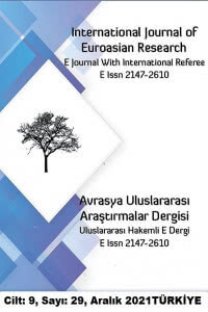ARAP DEVLETLERİNİN MİLLİ MARŞLARININ İÇERİKLERİYLE DIŞ POLİTİKA EĞİLİMLERİNDEKİ PARALELLİKLER
Bu çalışma, Arap devletlerinin milli marşlarındaki sözlere yönelik bir içerik analizi yaparak bu devletlerin dış politika istekleri ile marş sözleri arasındaki paralellikleri araştırmaktadır. Toplumların milli duygu ve hisleri ile bağımsız devletlerin varlık sebeplerini şiirsel bir anlatımla ortaya koyan milli marşlar, milli çıkarların kavramlaştırılması noktasında ve ülkelerin dış politika anlayışları hakkında önemli ipuçları taşımaktadır. Bu çalışma da, Mısır, Irak, Libya, Suudi Arabistan, Fas ve Ürdün milli marşlarını inceleyerek Arap cumhuriyetlerinin marşlarının Arap monarşilerine nazaran daha güçlü bir ton ve vatanseverlik temalı kelimeler kullandığını; bu tonun savaş ve çatışma dönemlerinde de daha fazla arttığını ortaya koymaktadır. Ayrıca, monarşilerin cumhuriyetlerden farklı olarak daha kısa marş sözleri tercih ettikleri ve hatta bazen hiç söz kullanmadıkları da eklenmektedir. Bu çerçevede, cumhuriyetler marşlara milli değerleri ve bağımsızlık hususundaki toplumsal hisleri güçlendirme açısından özel önem atfetmekte ve marşların seçimini milli yarışmalar düzenleyerek yapmaktadırlar. Arap cumhuriyetlerine bakıldığında, marşlarındaki değişikliğe paralel olarak dış politikalarında da değişiklik olduğu ortaya konulmaktadır. Arap cumhuriyetleri ne zaman daha çekişmeli bir dış politika sürecine girse, marşlarının da daha güçlü sözlerle eşlik ettiği; barış zamanlarında ise bunun tersine daha yumuşak bir tona geçtiği görülmektedir.
PARALLELS BETWEEN THE FOREIGN POLICY TENDENCIES OF ARAB STATES AND THE CONTENTS OF THEIR NATIONAL ANTHEMS
This paper investigates the parallels between the foreign policy aspirations of Arabstates and their national anthems by making the content analysis of their lyrics. The lyrics ofnational anthems, as poetic declarations of the national feelings and the raison d’état ofindependent states, present important clues about the national interest conceptualization andforeign policy orientation. After the content analysis of the national anthems of Egypt, Iraq,Libya, Saudi Arabia, Morocco and Jordan, this paper finds out that the lyrics of the anthems ofArab republics include more patriotic words and stronger tone than those of the monarchies;and their tones get stronger in times of conflict and war. Unlike republics, Arab monarchiesseem to prefer shorter lyrics and use their anthems even without lyrics for a long time.Republics attach specific importance to the anthems in terms of promoting the national valuesand expressing the feelings of their people about independence, and their anthems are mostlyselected by organizing national competitions. For Arab republics it would appear that thechanges in their anthems accompany the changes in their foreign policy. Whenever Arabrepublics involve in more conflictual foreign policy, their anthems accompany with stronger lyricswhile their tones get softer in the times of peace.
___
- AYALON, Ami (2000), “Post-Ottoman Arab Monarchies: Old Bottles, New Labels?" Middle East Monarchies, The Challenge of Modernity, (Ed. Joseph Kostiner), Boulder, Colo: Lynne Rienner Publishers.
- CERULO, Karen A. (1989), “Sociopolitical Control and the Structure of National Symbols: An Empirical Analysis of National Anthems”, Social Forces, Vol. 68, No. 1, p. 76-99.
- CERULO, Karen A. (1993), “Symbols and the World System: National Anthems and Flags”, Sociological Forum, Vol 8, No. 2.
- DANIELSON, Virginia (1997), The Voice of Egypt: Umm Kulthüm, Arabic Song, and Egyptian Society in the Twentieth Century, Chicago: The University of Chicago Press.
- HALLIDAY, Fred (2005), The Middle East in International Relations: Power, Politics and Ideology, Cambridge, UK: Cambridge University Press.
- HANG, Xing (2003) (ed.), Encyclopaedia of National Anthems, Lanham, Maryland and Oxford: The Scarecrow Press.
- HERB, Michael (1990), All in the Family: Absolutism, Revolution, and Democracy in the Middle Eastern Monarchies, Albany: State University of New York Press.
- HINNEBUSCH, Raymond (2003), The International Politics of the Middle East, Manchester, UK: Manchester University Press.
- Kāmil, 1. Muṣṭafʹa (1907), What the National Party wants: speech: delivered on 22nd October 1907 in the Zizinia Theatre at Alexandria, Cairo: Egyptian Standard.
- MESBAH, Hesham (2019), “Collective Identity in National Anthems: Investigating Commonalities and Differences Among African and Non-African Arab Countries”, Music and Messaging in the African Political Arena, (Ed. Uche T. Onyebadi), Hershey, PA: Information Science Reference, p. 45-64.
- MUSTAFA, Esra' (2015), “Semantic Framing of NATIONALISM in the National Anthems of Egypt and England”, International Journal of Applied Linguistics & English Literature, Vol. 4 No. 4, p. 62-76.
- ROGAN, Eugene L. (2009), “The Emergence of the Middle East into the Modern State System,” International Relational Relations of the Middle East, (Ed. L. Fawcett), Oxford, UK: Oxford University Press, p. 22-41.
- SCHLUMBERGER, Oliver (2010), “Opening Old Bottles in Search of New Wine: On Nondemocratic Legitimacy in the Middle East”, Middle East Critique, Vol 19, No 3, p. 233-250.
- ISSN: 2147-2610
- Yayın Aralığı: Yılda 4 Sayı
- Başlangıç: 2012
- Yayıncı: Kürşat Öncül
Sayıdaki Diğer Makaleler
BİR KÜLTÜR POLİTİKASI OLARAK HALKEVLERİNDE FOLKLOR ÇALIŞMALARI (BARTIN HALKEVİ ÖRNEĞİ)
CAN YÜCEL ŞİİRİNDE BİR VAROLUŞ BİÇİMİ OLARAK GÜZELDEN KAÇMAK
SOSYAL MEDYADA TÜRK ATASÖZLERİNİN DURUMU ÜZERİNE BAZI TESPİTLER
PANDEMİ SÜRECİNDE EĞİTİMİN DÖNÜŞÜMÜ: ÇEVRİMİÇİ EĞİTİMİN SOSYOLOJİK YANSIMALARI
İSLAM VE MÜSLÜMAN TOPLUMLARDA DEVLET VE SİVİL TOPLUM KAVRAMLARI: TARİHSEL VE SOSYOLOJİK BİR ANALİZ
İRAN İSLAM DEVRİMİ’NE GİDEN SÜREÇTE REX SİNEMASI FACİASI VE ETKİLERİ
HALKBİLİMSEL BAKIŞ AÇISI ve DİSİPLİNLERARASI BİR YAKLAŞIMLA HALKBİLİMİ ETİK ve METAETİK İLİŞKİSİ
PANDEMİ SÜRECİNDE EĞİTİMİN DÖNÜŞÜMÜ: ÇEVRİMİÇİ EĞİTİMİN SOSYOLOJİK YANSIMALAR
SES-ANLAM-DUYGU İLİŞKİSİNİ KAVRAMADA FONOLOJİK FARKINDALIĞIN ROLÜ: BİR DURUM ÇALIŞMASI
